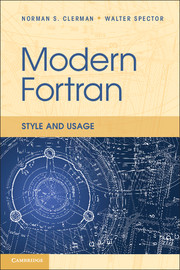Book contents
- Frontmatter
- Contents
- Source Code Listings
- Preface
- 1 Introduction
- 2 General Principles
- 3 Formatting Conventions
- 4 Naming Conventions
- 5 Documentation Conventions
- 6 Programming Principles
- 7 Programming Conventions
- 8 Input and Output
- 9 Packaging Conventions
- 10 Generic Programming
- 11 Object Orientation
- 12 Parallel Processing
- 13 Numerical Types, Kinds, and Operations
- 14 C Interoperability
- 15 Updating Old Programs
- A Source Code
- B Rule List
- Bibliography
- Index
8 - Input and Output
Published online by Cambridge University Press: 05 December 2011
- Frontmatter
- Contents
- Source Code Listings
- Preface
- 1 Introduction
- 2 General Principles
- 3 Formatting Conventions
- 4 Naming Conventions
- 5 Documentation Conventions
- 6 Programming Principles
- 7 Programming Conventions
- 8 Input and Output
- 9 Packaging Conventions
- 10 Generic Programming
- 11 Object Orientation
- 12 Parallel Processing
- 13 Numerical Types, Kinds, and Operations
- 14 C Interoperability
- 15 Updating Old Programs
- A Source Code
- B Rule List
- Bibliography
- Index
Summary
Reading data and writing results are fundamental operations that are common to almost all programs. Fortran provides a built-in set of input/output (I/O) statements. These statements generally operate on data files residing on disk drives, and with devices, such as keyboards and console displays, which can be presented to a program by the operating system in a file-like manner. Different devices have different capabilities, so not all operations are supported on each one. The executable I/O statements, divided into two groups, are shown in Table 8.1.
Fortran has always structured its I/O capabilities around the read and write statements. These statements operate on Fortran “units,” which are represented by simple cardinal numbers called “unit numbers.” A unit that is connected to a data file typically occupies system resources, such as buffers and file descriptors, from the time it is connected, when the file is opened, until the time it is disconnected using the close statement.
General I/O Operations
Use the named constants in the intrinsic module iso_fortran_env.
The intrinsic module iso_fortran_env provides named constants to help make applications portable. These named constants include values for standard input, output, and error unit numbers, such as INPUT_UNIT, OUTPUT_UNIT, and various values returned by the iostat specifier, such as IOSTAT_END, an argument common to many of the I/O statements that return an integer indicating the success or the failure of the I/O operation (see Rules 104 and 105).
- Type
- Chapter
- Information
- Modern FortranStyle and Usage, pp. 140 - 164Publisher: Cambridge University PressPrint publication year: 2011

